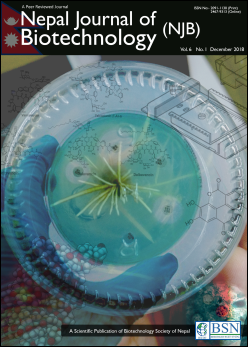Isolation and Screening of Antibiotics Producing Streptomyces spp from the Soil Collected around the Root of Alnus nepalensis from Godawari
DOI:
https://doi.org/10.3126/njb.v6i1.22337Keywords:
Actinomycetes, Alnus nepalensis, AntibioticsAbstract
Actinomycetes are considered as the most invaluable prokaryotes whose genome mining show a great number of putative secondary metabolite biosynthesis pathways as well as gene clusters ranging from 20 to 50 per genome. The genus Streptomyces has been explored for its ability to produce 60% antibiotics worldwide. Alnus nepalensis (Alder) has been found to harbor diverse Eubacteria in its rhizosphere. To evaluate the antibiotic production potential from Actinomycetes, we collected soil samples from rhizosphere (5-7 cm deep) of Alder tree. Primary screening was done by cross-streak method against Multidrug Resistant (MDR) such as Methicillin resistant Staphylococcus auereus (MRSA), Vancomycin resistant Enterococcus feacalis (VRE), Imepenem resistant Acinetobacterbaumannii, Vancomycin resistant Klebsiella pneumonia and Imepenem resistant E. coli as well as Non-MDRs (E. coli, Bacillus subtilis, Klebsiella pneumoniae, S. aeureu and Enterococcus feacalis). Extraction of antibiotics was done using rota-vapour from extract obtained by solid-substrate fermentation technique followed by solvent extraction. Secondary screening was done using well diffusion assay against MDRs. Among total of 40 isolates of Actinomycetes recovered, 14 showed remarkable zone of inhibition (ZOI) to various MDRs. NASA 303 showed 26 mm of ZOI against VRE, NASA 101 had ZOI of 34 mm against MRSA, NASA 319 had 33.7 mm ZOI against Imepenem resistant E. coli, NASA 306 had 36 mm of ZOI against Vancomycin resistant Klebsiella pneumoniae, and NASA 108 showed ZOI of 29.6 mm against Imepenem resistant E. faecalis. This investigation revealed that the Actinomycetes found in Rhizosphere of Alder tree had MDR killing potent antibiotics, which needs to be further explored.
Downloads
Downloads
Published
How to Cite
Issue
Section
License
Copyright Notice:
The manuscript submitted to NJB must be an original contribution, not previously published and should not be under consideration for publication elsewhere. When the manuscript is accepted for publication, the authors agree to automatically transfer the copyright of the article to the publisher. It should grant permission to any third party, in advance and in perpetuity, the right to use, reproduce or disseminate your article, according to the NJB copyright and license agreement.
Authors transfer copyright to the publisher as part of a journal publishing agreement but have the rights to: Share their article for Personal Use, Internal Institutional Use and Scholarly Sharing purposes, with the NJB applies the Creative Commons Attribution-NonCommercial CC BY-NC license to all the works we publish after Jun 2020 (Before it was CC BY-NC-ND). Under this license, authors agree to make articles legally available for reuse, without permission or fees, for virtually any non-commercial purpose. Anyone may remix, adapt, and build upon your work non-commercially, and although their new works must also acknowledge you and be non-commercial, they don’t have to license their derivative works on the same terms. More details on CC BY-NC refer to its Licence Deed and Legal Code.






